Content
Dzhungarian aconite is one of the most poisonous plants. However, when used correctly, the herb can be beneficial and contribute to the cure of diseases.
Description of the species
Dzungarian aconite, or fighter (Aconitum soongaricum), is a perennial plant from the Buttercup family. It is also found under the names of wolf root, skullcap and tsar-grass, has a long stem, naked or pubescent. The leaves of the Dzungarian aconite are round-heart-shaped, arranged in the next order. They are dark green above, slightly lighter in the lower part, dissected into several wedge-shaped lobes. The rhizome consists of large tubers fused together in a horizontal chain like a rosary.
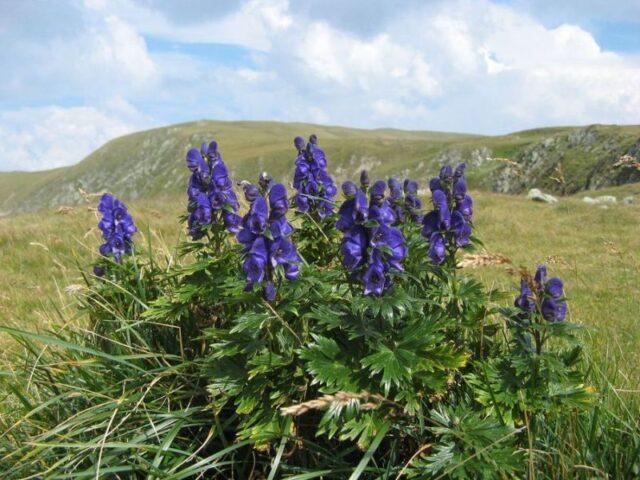
Dzungarian aconite can rise up to 2 m above the ground
In the second half of summer, the plant brings carpal apical inflorescences, represented by large blue-violet buds of irregular shape. By autumn, it bears fruit - dry three-leaflets with numerous seeds.
Where does Dzungarian aconite grow
A perennial plant is widespread in North America, China, Europe, Nepal and the Himalayas, in Russia. Selects most often river banks and alpine meadows, found in mixed forests.
The poisonousness of the plant
Dzungarian aconite is considered a very poisonous plant and poses a great danger to human health. Only 1 g of perennial root is enough for the poisoning to be fatal. The highest concentration of toxic substances is present in the tubers of the plant, but the ground parts are also very harmful. Intoxication is caused not only by the use of Dzungarian aconite inside, but also by external contact with its juice, as well as inhalation of the aroma.
The degree of toxicity depends on the time of year and the location of the perennial. Specimens growing in wet meadows and swamps are considered less toxic. Summer tubers are not as poisonous as autumn and spring tubers. At the same time, for medicinal purposes, it is recommended to collect underground parts just before or after the end of the growing season.
Collect only with gloves and a face shield. On contact with the skin, the sap of the plant causes itching and burning, and then numbness, as after exposure to a local anesthetic.
Composition and value
Dzungarian aconite is taken for treatment, although it is very poisonous, it also contains useful substances. Among the active ingredients are:
- natural sugars;
- saponins;
- coumarins and resins;
- starch and flavonoids;
- citric, linoleic and palmitic acids;
- pseudoaconitine and daucosterol;
- ascorbic acid;
- mesoinosidol;
- inositol and tannins;
- atisine alkaloids;
- trace elements;
- stearic and benzoic acids.
The toxicity of Dzungarian aconite is due to the presence of aconitine alkaloids in its composition.Substances of this group can lead to respiratory arrest and cardiac paralysis in less than an hour.
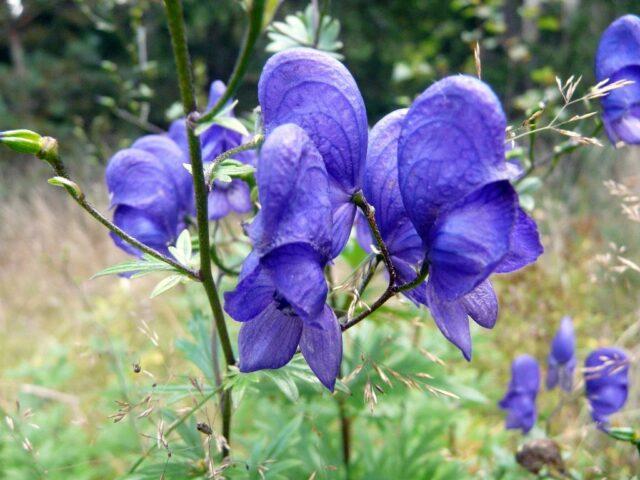
There are no specific antidotes to aconitine, the most dangerous component of aconite.
Healing properties
Poisonous Dzungarian aconite is used in folk medicine in meager dosages for the treatment of diseases. Its valuable properties are used:
- with hypertension, arrhythmias and angina pectoris;
- with anemia;
- with hormonal disruptions and infertility;
- with diabetes mellitus;
- with diseases of the kidneys and gallbladder;
- with bronchitis, asthma, tuberculosis and pneumonia;
- with neuralgic disorders;
- with inflammatory diseases and injuries of the joints;
- with psoriasis, eczema and neurodermatitis.
Outwardly, Dzhungarian aconite is used in the treatment of scabies and head lice. The plant has a pronounced antiparasitic effect.
Recipes for decoctions and tinctures of Dzungarian aconite
Most often, a poisonous plant is used to prepare strong tinctures. Perennial active substances dissolve best in an alcohol base. There are also recipes for water decoctions of the plant.
Tincture for heart disease and oncology
Dzungarian aconite inhibits cardiac activity, but in small doses it can be beneficial for hypertension, arrhythmias and cancer. The recipe for a medicinal tincture looks like this:
- 10 g of flowers or seeds of a plant are poured with 500 ml of high-quality vodka;
- in a closed glass container, remove to a dark place for two weeks;
- from time to time, remove the vessel and shake the contents.
At the end of the period, the tincture is filtered through cheesecloth. You can take it inside according to the "slide" scheme - with a gradual build-up, and then a gradual decrease in dosage.
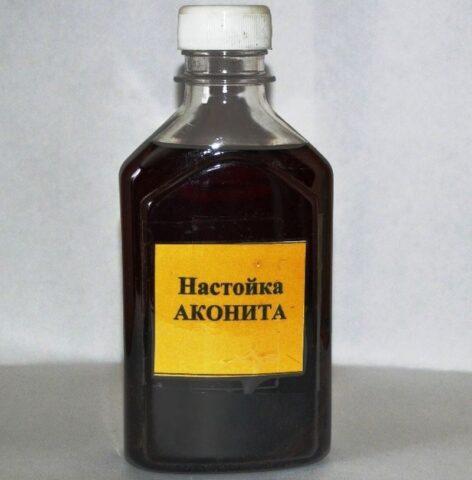
Tincture of aconite is consumed in the morning on an empty stomach once a day
Tincture for rubbing
The agent for external use is prepared according to the classic recipe, but the volume of medicinal raw materials is increased. The algorithm looks like this:
- 50 g of crushed root is poured with 500 ml of vodka;
- shake the closed vessel and remove to a dark place for 14 days;
- after a lapse of time, filter through folded gauze.
The finished tincture is used for rubbing the skin with sciatica, rheumatism, sprains and bruises. It also helps to remove lice and scabies mites. It is forbidden to take the agent inside, it has too high a concentration.
Decoction for furunculosis
For abscesses, boils and abscesses, an aqueous decoction of the tubers of Dzhungarian aconite is prepared. The recipe looks like this:
- 10 g of crushed raw materials are poured into 1 liter of hot water;
- bring to a boil;
- boil over medium heat for 20 minutes;
- cool and filter the product.
Boils and abscesses are rubbed with a ready-made broth. Aconite has strong anti-inflammatory properties and helps to speed up the healing of the epidermis.

A decoction of aconite roots is used for hematomas, sprains and even fractures
Application of tincture of Dzhungarian aconite
Alcohol tincture of aconite is used for serious diseases. At the same time, it is important to follow proven algorithms and not violate the proposed dosages.
How to take Dzhungarian aconite for oncology
Aconite can be beneficial for cancer. In the early stages and in the phase of active treatment, it is not accepted to use it. But in the last stages of cancer, it is recommended quite often. Reviews on the use of tincture of Dzungarian aconite confirm that in some cases the herbal preparation significantly prolongs the life of patients. In addition, there is a strong analgesic effect, which makes it possible to reduce the consumption of the corresponding drugs.
For medicinal purposes, such a remedy is prepared:
- the dry tuber of the plant is crushed in an amount of 5 g;
- pour raw materials with 500 ml of vodka;
- for two weeks, remove the product in a dark place for infusion;
- when ready, filter the sediment through a sieve or folded gauze.
It is necessary to use the tincture three times a day, just one drop, previously diluted in a small amount of water. Every day, the dosage is increased by another drop, until the single volume is ten drops.
After that, the indicated amount is taken for ten days in a row. Then the dosage begins to be gradually reduced as well and the therapy ends when the single volume is again one drop. At the end of the course, you need to take a break for 1-5 months.
In the treatment of boils and purulent wounds
Dzungarian aconite relieves inflammation, has a pronounced bactericidal effect and contributes to the early recovery of the skin. For boils and purulent wounds, a decoction of the plant is used. The recipe looks like this:
- dry aconite tubers are chopped with a sharp knife or grater;
- 5 g of raw materials are poured with 500 ml of hot water;
- boil on the stove after boiling for 20 minutes;
- cool the product and filter through cheesecloth.
A cotton pad is dipped into the ready-made warm solution and the affected areas are wiped. Immediately after using a decoction of Dzungarian aconite, wash your hands thoroughly.
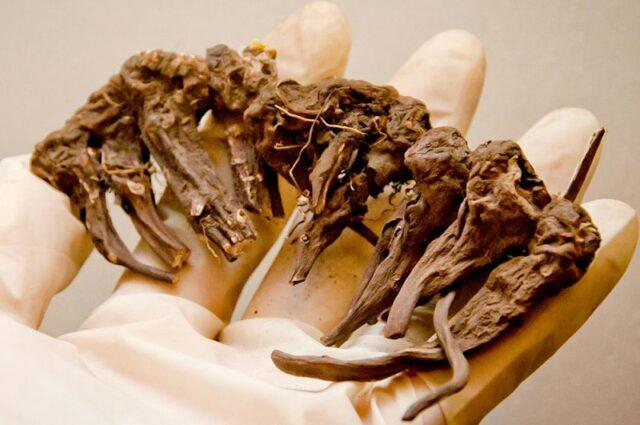
It is not recommended to treat the skin of the face and neck with tinctures and decoctions of aconite
For pain and bruises
Dzungarian aconite has pronounced analgesic properties and has a good effect on bruises, joint ailments, neuralgia and migraines. For treatment, prepare the following tincture:
- 10 g of dry plant tubers are crushed to a powder state;
- pour raw materials with 500 ml of vodka or diluted alcohol;
- insist in a dark place for a week.
After the drug acquires a rich brown hue, it will need to be filtered through cheesecloth. Use tincture of Dzhungarian aconite for compresses for rheumatism and radiculitis and for rubbing with neuralgia and migraines. In all cases, the agent is applied to the diseased areas in a minimum amount of no more than 30 drops, and after 40-60 minutes the skin is washed with warm water.
Side effects of Dzhungarian aconite
Officially, the lethal dosage of Dzungarian aconite is 1 g of fresh crushed root. In decoctions and tinctures based on the plant, the concentration of hazardous substances is much lower. However, if the dosages are not observed, medicinal agents can still cause severe poisoning.
Symptoms of aconite intoxication are:
- severe burning of the mucous membranes in the mouth and swelling of the tongue;
- increased salivation, perspiration and increased urination;
- dilated pupils and visual impairment;
- headache, facial flushing and tachycardia;
- nausea and vomiting;
- trembling limbs and cramps;
- choking and fainting.
Dzhungarian aconite poisoning develops very quickly, in the absence of medical care and a serious excess of the dosage, cardiac arrest can occur in less than an hour. When the first characteristic signs appear, it is necessary to immediately induce vomiting in the patient, and then force him to drink a large amount of pure water and re-empty the stomach.
Washing at home will remove some of the toxins from the body, but will not completely eliminate the poisoning. A doctor should be called even before assistance begins.
Contraindications
With all its useful properties, tincture of Dzungarian aconite poses a great danger to the body. It is necessary to completely abandon its use:
- during pregnancy;
- during lactation;
- with hypotension and bradycardia;
- with chronic liver and kidney diseases;
- with inflammatory diseases of the heart.
It is strictly forbidden to give aconite tincture and decoction to children and adolescents up to 18 years old. This applies not only to internal, but also external use of drugs, even through the skin, the plant has a toxic effect. It is not recommended to resort to treatment with poisonous grass with a tendency to allergies, especially if you have previously suffered anaphylactic shock.
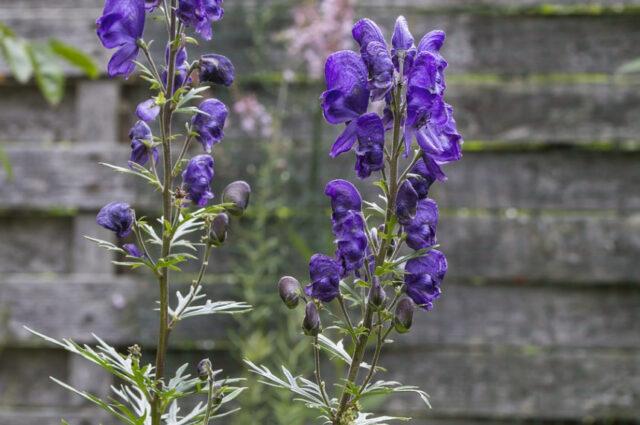
Dzhungarian aconite poisoning develops within two hours after an overdose
Reviews of the tincture of Dzungarian aconite note that any use of the plant should be coordinated with the attending physician. The drug can be made at home or bought at a pharmacy, but it is forbidden to prescribe it to yourself on an unauthorized basis. Only a qualified specialist can weigh all the risks associated with using the plant in a particular situation.
Conclusion
Dzhungarian aconite is a very toxic plant that requires careful use. In homeopathic dosages, tinctures and decoctions based on perennials have a beneficial effect on the body and increase its resistance even in cancer. But exceeding the permitted volumes threatens with serious consequences, including death.
Reviews of the treatment with Dzhungarian aconite








